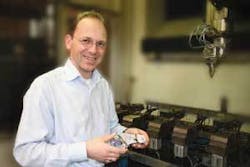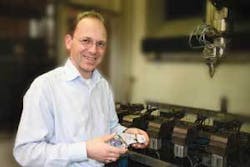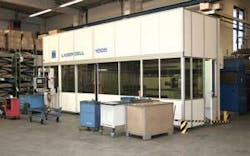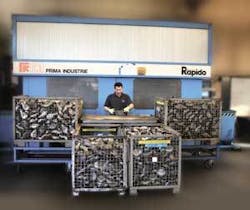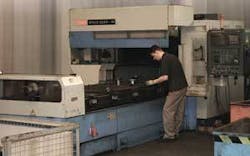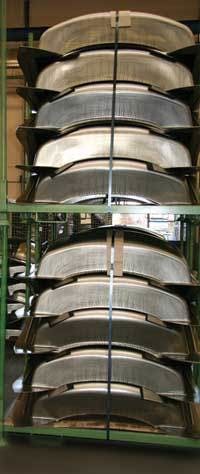3D from the start
Franz J. Gruber
VIA Lasertec is among the few exclusive 3D laser service providers
Many classic laser job shops became involved with three-dimensional (3D) laser materials processing early on and some expanded the offerings in this area, but it didn’t always go well. In many cases, an expensive multi-axis system could barely make a living compared with the everyday 2D. The possibility of being able to use 3D, thus offering customers added value if needed, can be profitable even at minimal utilization.
The situation is different among the “3D specialists”-where machine utilization has to be supported only by three-dimensional laser processing. As a consequence, a respectable amount of 3D know-how has been established at such companies. This is true in Kirchhundem, Germany, at VIA Lasertec (www.via-lasertec.de), a service provider that has done only 3D from the start. Note, in full disclosure, there is also a 2D cutting system in Kirchhundem, although at closer look, we can see that it is actually “2.5D” with the Z axis of a Mazak Space Gear used more often at VIA than elsewhere.
Ralf Polzin, the company’s business manager, explains, “We also do 2D, but we still aren’t going with large numbers of units. We are more involved in the prototype business, which means low numbers of units but also minimum delivery time, that is, within 48 hours. Our focus is definitely the 3D processing-80 percent cutting, the rest is welding.” To do this, the company has a total of four multiaxis systems available: three Lasercell 1005 from TRUMPF and a Rapido from Prima Industrie.
The company was founded purely and simply for three-dimensional laser processing in 1998 by several automotive suppliers from southern Sauerland that had already participated together in a number of activities-several companies that were founded with special competencies were followed by a purchasing association. This Association of Innovative Automotive Suppliers, the name VIA is from the German translation, on one hand had its own needs and on the other, could see a promising future business; and that came true after almost ten years.
VIA Lasertec has long been an independent company acting freely in the market with only a fraction of the work it handles from orders of the other partner companies. The majority of the customers come from Nordrhein-Westfalen, where the regional metal-processing industry is focused. But that’s the way it is with 3D: there still aren’t that many companies and still fewer with the appropriate know-how that also have the confidence for this unusual specialty. Because of this, special orders from all over Germany find their way to Kirchhundem.
As a genuine laser job shop, laser cutting and/or laser welding are the most important processes offered at VIA Lasertec. The search for complete sheet metal processing with everything that goes along with it would be in vain. However, it is important to know that there are several sister companies in the VIA association that can perform edge processing, welding, assembly, or painting, which means it is possible to bid the complete package. As Polzin says, “Surely we have to align ourselves to the market and if it were necessary to have a folding press in-house, we would certainly have one soon. But our focus is, and will remain, 3D laser material processing.” However exceptions are the rule and VIA Lasertec maintains a room for precision measuring that is set up respectably where-in addition to in-house needs-measuring services are offered.
The first true 3D system at VIA was a TRUMPF TLC 1005-two others followed later, the most recent a year and a half ago. All three systems are essentially identical, if the amount of laser power is not considered. The oldest operates with a 2.4kW laser and the other two, with 5 kW each, are mainly used as welding systems; which is not to say that they wouldn’t be used for cutting, and it also doesn’t mean that welding is not done on the 2.4kW TLC. Being able to exchange orders among the machines with no problems means a high degree of flexibility. Polzin emphasizes this advantage: “They not only have to be good, but they also have to be fast to be able to act on this market. In that case, being able to use the three systems variably is a plus point. Of our entire spectrum, 80 percent can be rotated among these three systems and thus fast response times are insured.”
Despite all the desired similarities, when you take a closer look you see that the three TLCs are also specialists, on one hand, because of the different amounts of laser power. On the other hand, there are also outstanding extras, as Polzin states, “For example, one has a cycled table that can be equipped in various ways. Another has implemented a rotational axle which makes it a specialist in pipe processing.”
Automation is still a delicate matter in the 3D area and thus manual programming of the systems also dominates at VIA. Automation only exists in the form that-for example during welding-multiple fixtures can be used for the workpieces. These fixtures are designed and built in-house. The laser utilization is also very high without automation; the possibility of separating the work rooms of the Lasercell systems and thus allow loading and unloading that are parallel in time also contributes to this.
This two-station operation is everyday business at VIA, where according to Polzin, “We hardly have any opportunities for getting into automation concepts in a big way. In this trade, it depends very greatly on the know-how of the employees. As before, a lot of intuition and experience are necessary that robots cannot offer. We work with formed parts that are subject to certain fluctuations in their manufacturing tolerances so there is no way to be successful without employee know-how.”
The Rapido was purchased exclusively for one order that involves quantities in the millions. In this case flexibility plays a subordinate role. It cuts the same steel part with a laser power of 4 kilowatts day in and day out and pays for itself with that alone. Actually such large quantities in the range of millions are the exception; orders for parts with several thousand units occur more frequently. Still it’s the same as “lot size of one;” it is everyday business at VIA.
As already mentioned, cutting dominates, not just of functional formed parts but also outer skin parts for elegant automobile bodies. The fact that automotive manufacturers are turning more and more to high-strength sheet metals and that a considerable market potential is opening up for laser cutting are also recognized with satisfaction at VIA Lasertec. This tool that is free of wear can be introduced into series manufacturing-obviously providing lucrative prospects for a 3D service provider like VIA Lasertec.
Outside of automotive there are more 3D parts than a person might think, for example in the sanitary area, white goods, general machines and vehicle building, the foodstuffs industry, and systems building and container construction. A glance into the VIA Lasertec sample room underlines this impressive variety and indicates that the prospects for 3D laser processing are good. Polzin emphasizes this assumption with his mention of expansion plans: “This year, we will buy another system and then take a look at 3D processing-which might mean a “bending arm robot plus solid-state laser.”
It is important to know that Polzin was previously at Thyssen Lasertechnik and still feels completely at home with the subject of robots. So it could be that a robot solution will find its way to VIA Lasertec, under certain circumstances, even a robot portal. Polzin says, “I wouldn’t rule out a portal system with suspended robot and fiber laser being here within the next year. That would further increase our flexibility, above all with respect to larger processing areas.”
But as he explains, there are still some details to clarify before a final decision is made: “The fiber laser is best suited for welding, no question. But I would have to look very closely at what it brings to cutting. We need a solution that can do both well.” That is part of it. The other part is that he knows very well that his CO2 lasers are work horses. The decision that will have to be made soon in Kirchhundem is certainly not easy.
This article was adapted, with permission, from one that appeared in Franz Gruber’s magazine EuroLaser in April 2007.
